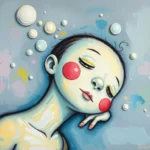
Introduction
Dreams have fascinated humanity for centuries, captivating our imaginations and prompting us to ponder their meanings. As we drift into the realm of sleep, our minds weave intricate narratives filled with symbolism, emotions, and vivid imagery. The importance of dreams lies not only in their entertainment value but also in their potential to reveal insights about our subconscious thoughts, fears, and desires. The intricacies of these night-time visions provide a unique glimpse into our inner selves, making them a subject of great intrigue for psychologists, philosophers, and spiritual seekers alike.
In this article, we will explore the symbolism and meaning of night-time dreams, delve into key scenarios and variations, and offer practical insights on how to connect these dreams to real-life situations. By understanding the messages conveyed through our dreams, we can embark on a journey of self-discovery and personal growth.
Symbolism and Meaning
Dreams are rich with symbolism, often using metaphors that speak to our emotions and experiences. Common symbols can vary widely among individuals but often share universal themes. For instance, falling in a dream may symbolize feelings of loss of control or insecurity in waking life. Alternatively, flying might denote a sense of freedom or escape from the pressures of daily routine.
Water is another prominent symbol in dreams, representing emotions and the unconscious mind. Calm waters can signify tranquility, while turbulent waters may indicate emotional turmoil or unresolved conflicts. The context of the dream plays a crucial role; a soothing river might reflect a sense of peace, while a stormy ocean could represent overwhelming feelings.
Buildings are also significant symbols, often reflecting the dreamer’s psyche. A dilapidated structure may point to neglected aspects of oneself, while a towering skyscraper can signify aspirations and ambitions. In contrast, being lost in a maze-like environment may suggest confusion or a search for direction in life.
The animals that appear in dreams can also carry important meanings. For example, a snake might symbolize transformation, fear, or hidden threats, while a butterfly often represents change or rebirth. The interpretation of these symbols can vary based on cultural backgrounds and personal experiences, making it essential to consider the dreamer’s unique perspective when analyzing their dreams.
Key Scenarios and Variations
Dreams can take numerous forms, and the specific scenarios that unfold can drastically affect their interpretation. For instance, a dream about being chased can evoke feelings of anxiety, suggesting that the dreamer may be avoiding a particular issue or feeling overwhelmed by responsibilities. On the flip side, a dream where one is the pursuer might indicate a desire to confront challenges or to take control of a situation.
Another common scenario is the dream of public speaking or performing in front of an audience. This type of dream often highlights feelings of vulnerability, fear of judgment, or the pressure to meet expectations. The success or failure of the performance in the dream can provide insights into the dreamer’s self-esteem and confidence levels.
Dreams about losing teeth tend to elicit anxiety and discomfort. They can symbolize feelings of helplessness or concerns about appearance and aging. In some cultures, these dreams may also represent a fear of losing one’s voice or ability to communicate effectively.
Conversely, the scenario of reuniting with a loved one who has passed away can evoke a deep sense of connection and closure. This type of dream may serve as a comforting reminder of the love and memories shared, allowing the dreamer to process their grief and maintain a bond with the deceased.
The context and emotions surrounding these scenarios are vital. For example, a dream about a wedding can symbolize new beginnings and commitment, but if the dreamer feels anxious or trapped during the ceremony, it could indicate feelings of pressure or fear regarding personal relationships.
Real-Life Connections and Takeaways
Connecting dreams to real-life situations can provide profound insights and prompt self-reflection. To do this effectively, one must begin by examining the emotions felt during the dream. Were you happy, anxious, or confused? Recognizing these feelings can help identify underlying issues or desires that may be manifesting in waking life.
Keeping a dream journal is an excellent way to cultivate self-awareness. By recording dreams upon waking, individuals can track recurring themes or symbols that may point to unresolved conflicts or aspirations. Over time, patterns may emerge, revealing deeper psychological insights.
Additionally, it can be beneficial to explore how specific dream scenarios resonate with personal experiences. For instance, if a dream involves being chased, consider recent situations where you felt overwhelmed or pressured. Are there aspects of your life that you are avoiding? Reflecting on these questions can spark valuable realizations.
Furthermore, engaging in creative visualization techniques can help individuals harness the power of their dreams. After recalling a particularly vivid dream, take a moment to visualize the scenario in a positive light. For example, if you dreamed of being lost, imagine finding your way to safety and clarity. This practice can reinforce feelings of empowerment and control.
Moreover, sharing dreams with trusted friends or family members can provide additional perspectives and insights. Often, others can identify symbols or themes that may be overlooked by the dreamer, further enriching the understanding of the dream’s message.
Lastly, it’s essential to approach dream interpretation with an open mind. Dreams are highly subjective, and what resonates for one person may not hold the same significance for another. Embrace the notion that your dreams are unique to you, and trust your instincts in deciphering their meanings.
Conclusion
Night-time dreams serve as a fascinating window into our subconscious, offering valuable insights into our emotions, desires, and fears. By exploring the symbolism and meaning behind various dream scenarios, we can better understand ourselves and our waking lives. These dreams not only entertain but also invite us to embark on a journey of self-discovery and personal growth.
As you reflect on your dreams, take the time to consider their significance in your life. Keep a journal, engage in creative visualization, and don’t hesitate to share your experiences with others. Ultimately, the exploration of dreams can lead to a deeper understanding of who we are and what we truly desire.
In the grand tapestry of life, dreams are not mere fragments of imagination; they are powerful messengers guiding us toward a more profound connection with our inner selves. Embrace the mysteries of your night-time visions, for they hold the keys to unlocking your subconscious and navigating the complexities of existence.







